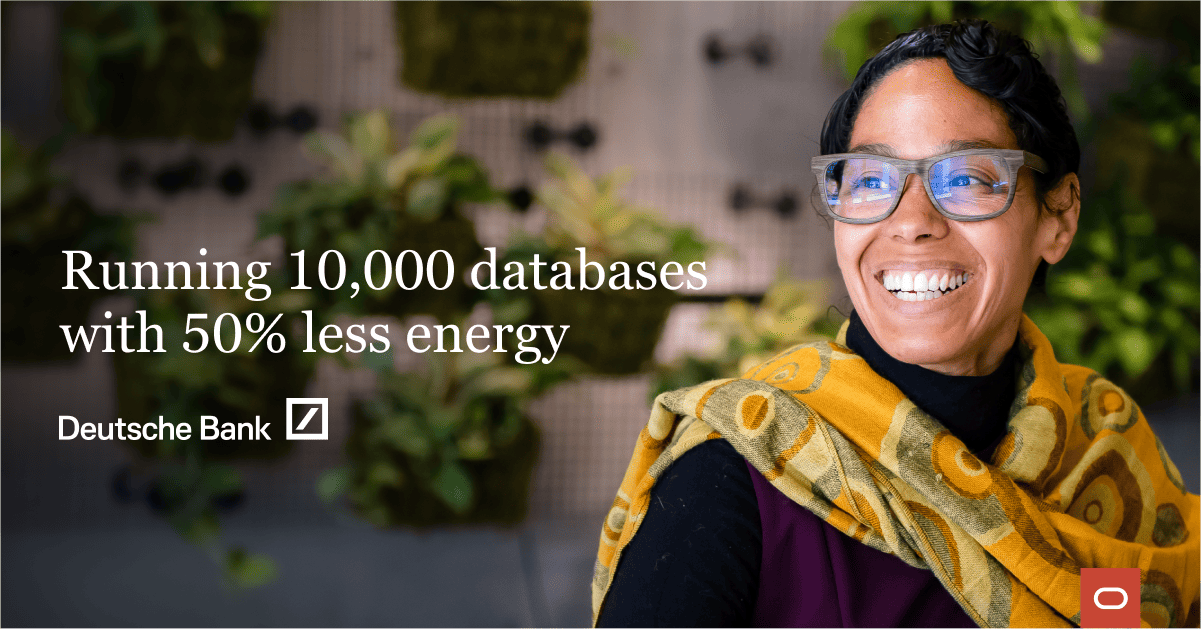The bank has moved about 1,300 Oracle Databases to a cloud computing environment it says will cut energy use in half and reduce costs.
As European banks work to increase profitability while reckoning with an uncertain economic landscape and growing regulatory pressures, Germany’s largest financial institution is accelerating a technology overhaul to save hundreds of millions of dollars and make it more competitive.
Deutsche Bank has moved around 1,300 Oracle Databases to a new system that can speed up analysis, process payments faster, cut energy usage in half and reduce costs. The massive IT project—which aims to upgrade 7,000 Oracle Databases across the Frankfurt-based bank’s global data centers to newer versions running on a database cloud platform—could save triple-digit millions of euros in costs. Overall, including backups, the bank will run 10,000 Oracle Databases.
The project is part of the bank’s management board’s plan to create more than €2.5 billion in operational efficiency over the next three years and reinvest it in the business. Improving the bank’s IT has been a pillar of the strategy and includes decommissioning old systems, merging others, and striking partnerships with large tech suppliers. The bank is moving its databases to Oracle Exadata Cloud@Customer, a service Oracle manages that lets the software and computers running them reside in Deutsche Bank’s data centers around the world.
“The banking industry as a whole is under pressure to get its costs under control,” Chief Technology Officer Gordon Mackechnie says. “We’ve done a great job over the past three years of streamlining. We very much see the Oracle Cloud@Customer transition as being an important part of that.”
The set-up lets Deutsche Bank benefit from better performance and lower costs while complying with increasingly divergent data residency rules in the countries where it does business, says Global Head of Database Services Marcus Praetzas. At the same time, the bank is upgrading to Oracle Database 19 from older versions of the software. Praetzas expects the next wave of 6,000 database migrations to happen much more quickly. “We need to pick up speed,” he says.
Banks must improve IT operations to keep up with rising volumes of data that need to be analyzed, increased electronic payment processing since the pandemic, and a complex global patchwork of rules that require them to report more data to meet local regulations. Despite revenue increases, costs are still growing faster than sales for many banks, according to consultancy McKinsey & Co. But Deutsche Bank has been on the mend: its first quarter 2023 pre-tax net profit rose 12% to €1.9 billion ($2 billion), the highest in a decade—and revenue rose 5% from a year earlier.
For the bank, a bet on technology to help propel future growth and to keep up with features offered by agile fintechs is part of its transformation strategy. Bernd Leukert, management board member responsible for technology, data and innovation, has struck partnerships with major technology companies, including Oracle, making cloud computing and AI cornerstones of his approach.
Leukert’s group has also hired more software developers and invested in IT security and customer risk controls.
“As fintech assumes more of the bandwidth for banks’ growth prospects, the use of cloud technologies to consume, understand, and deploy data is spinning the entire axis of financial services firms,” says Eric Gebaide, a managing partner at IA Global Capital, a New York-based investment bank focused on technology and working with companies that consult on cloud transitions. “There isn’t one financial services firm which isn’t trying to be more cloud-centric.” Yet large companies can sometimes underestimate public cloud environments’ total cost over time by 50% or more, undercounting the price tag of additional software needed to move and manage data. “It starts to spiral,” he says.
Massive question
In addition to cutting energy usage and costs, Praetzas expects to halve the number of service interruptions the bank’s business groups see when interacting with its data processing and analysis systems. Energy usage is increasingly important to companies as they aim to hit sustainability targets set by governments and investors. Deutsche Bank is able to consolidate an average of 100 databases onto each Exadata machine, five times more than under its previous arrangement.
Oracle’s Exadata architecture lets businesses run its database on high-performance servers that include direct access to computer memory from storage, and a high bandwidth low-latency internal network. Under the Cloud@Customer arrangement used by Deutsche Bank and others, Oracle owns and manages the Exadata machines inside those customers’ data centers. That gives Deutsche Bank many benefits of cloud computing by eliminating hardware maintenance, while helping it meet data residency and security requirements, such as the European Unions’s General Data Protection Regulation and India’s rules on local payment data. “We see data residency as a massive, ongoing question,” says Mackechnie.
Deutsche Bank also gains advantages in analytical reporting and payment processing, which strain computers in different ways. “This is where the architecture of Exadata and Exa CC helps us,” says Praetzas. Data analysis benefits from Oracle’s Exadata’s compression capability, which lets reports run faster. That’s important as reporting requirements and the “granularity” of information needed to feed them rises yearly. “It’s analyzing a huge data volume,” he says.
Processing electronic payments on the other hand requires moving data swiftly among servers—including the Oracle Database running on Exadata that powers Deutsche Bank’s interface to the global SWIFT payment network among banks. “Payments is throughput—get it through as fast as you can,” Praetzas says. The more time companies spend computing in the cloud the higher their bills, so Exadata’s performance can contribute to lower costs by dispensing with jobs quickly.
One platform
The bank can also ensure it continues to comply with regulatory requirements for applying security updates as it moves to a unified, up-to-date system. “It’s simply easier to have one platform than five to update,” Praetzas says. Using Oracle Exadata’s high-availability features, the database group can apply patches without bringing the software down. That’s important for banking applications that need to run constantly, such as those for regulatory reporting, wealth management, corporate banking, and payments.
Deutsche Bank and Oracle are working closely on more than 60 “enhancements,” or unique features the bank requests that are also useful to Oracle’s other customers in the sector. Using Oracle Cloud Lift Services, which provide top engineering support for migrations, and tools including Oracle’s Zero Downtime Migration technology, the bank said it’s realized a 100% success rate in moving the databases.
The database migration milestone and plans to accelerate movement to the latest technology show Deutsche Bank is executing, not just showing strategy on a slide. “We use Oracle to run a lot of our most mission-critical systems,” Mackechnie says. “We’re able to build more and more of those more sophisticated customer interactions on a stable and sound base, which is in a lot of cases provided by Oracle.”
Also read: Financial sector is in the midst of major digital innovation drive

